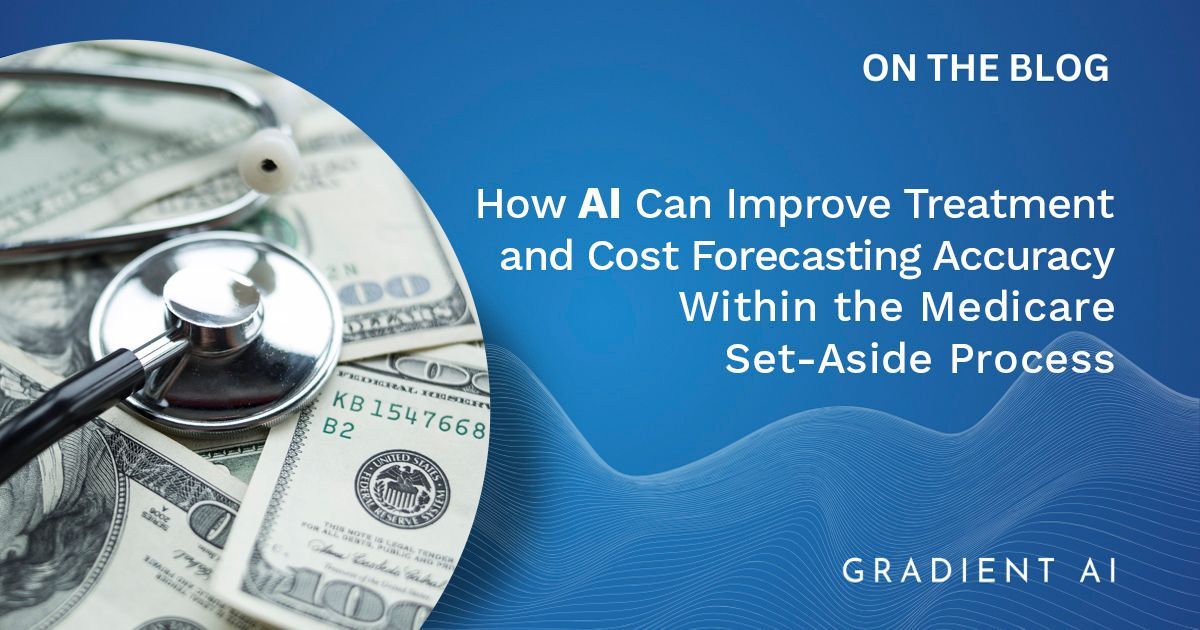How AI Can Improve Treatment & Cost Forecasting Accuracy Within the Medicare Set-Aside Process
In a previous blog post, we discussed how AI and automation can streamline the Medicare Set-Aside (MSA) process by reducing manual documentation processes and assisting with regulatory compliance. In this blog, we’ll focus on the challenges in treatment and cost estimation within MSAs. We’ll also look at how AI-driven solutions can help improve these processes in workers’ compensation programs.
The treatment and drugs included in the cost projection tables within an MSA are drawn from medical records, as well as past medical history. Given the number of medical reports associated with older claims, review of these records can be a lengthy process, often taking several hours or more. In the past, however, this was the only method of ensuring all future treatment recommendations were identified. But now, AI-assisted record review has emerged as a game changing approach.
Two Challenges in MSA Treatment Forecasting and Cost Estimations
1. Treatment Forecasting Inefficiencies
The current MSA process is laborious. First, a specialized allocator physically goes through the injured worker’s medical records, creating a summary of the injury and the medical treatment. For each treatment, the allocator must determine whether the recommended treatment has been provided to the injured worker. Any unfulfilled recommendations must be included in the MSA. Next, a treatment plan is developed based on physician recommendations for specific treatments such as surgeries, diagnostic testing, hospitalizations, etc., as well as treatment corresponding to CMS’s standardized guidelines. Last, the allocator prices the services and drugs under the treatment plan using state fee schedules and other pricing resources specified by CMS and recommends an MSA amount for the claim.
All of this can take from several days to over a week, which unfortunately leads to delays in claim closure and settlement funds being paid to injured workers. In addition, the existing approach often leads to unpleasant surprises for claims managers. Unrecognized treatment recommendations often, consequently, increase the overall MSA amount, sometimes making the settlement impossible.
2. Cost Projection Inaccuracies
It is challenging to accurately estimate future medical costs within the current MSA framework. Most services are priced out based on state workers’ compensation fee schedules or, when unavailable, usual, customary and reasonable (UCR) fees for the jurisdiction. As fee schedules are unique to each state, and fees are updated as often as quarterly, determining the correct pricing can be a complex process. Also, as the claimant’s medical condition and health status change over time, often necessitating new and different treatments, the amount allocated in an MSA may not accurately reflect the future funds needed. Compounding this, CMS requires MSAs associated with settlements to have been done within the past six months. After this point, they are considered stale-dated, leading to additional costs for the claims payer, both for multiple MSA updates and increasing treatment fees over the course of lengthy settlement negotiations and proceedings.
AI Solutions Address These Challenges and Enhance MSA Management in Workers’ Comp Programs
AI solutions can significantly improve MSA operations by addressing inefficiencies in the identification of future medical treatments. By analyzing vast amounts of medical reports, generative AI can detect treatment recommendations within the records, compare them to structured medical payment data for treatment already provided to the injured worker, and flag treatment yet to be provided. These insights allow allocators to readily identify services and drugs for inclusion in the MSA.
For example, by analyzing historical treatment data, AI can determine specific treatment frequencies for evaluations, therapy, and surgical revisions, as well as the injured worker’s current drug regimen. This data helps MSA allocators make better decisions when forecasting treatment and drugs, which leads to improved cost savings and more accurate funding of the MSA.
MSA cost projections can also be more accurate by leveraging AI. Predictive analytics can monitor trends, analyzing information in real time. In cases where settlement hasn’t occurred, it can automatically recommend changes to the MSA to meet the changing medical conditions and related treatment needs. AI also notes important things that can change, such as evolving treatment plans, how medication is used, and how much things cost. It can also identify and flag escalating cost-drivers such as costly surgeries or procedures early on with suggested actions on how to address each cost driver to mitigate costs.
As healthcare continues to evolve, AI will become even more critical to streamlining operations to achieve better outcomes and ensuring the long-term success of workers' compensation programs.
Learn More
Explore how Gradient’s AI-driven solutions can transform your workers’ compensation operations. Contact us today to learn more about solutions that can streamline your process.
About Gradient AI
Gradient AI is a leading provider of proven artificial intelligence solutions for the insurance industry. Our solutions improve loss ratios and profitability by predicting underwriting and claims risks with greater accuracy, as well as reducing quote turnaround times and claim expenses through intelligent automation.
©2024 Gradient AI All rights reserved | Terms of Use | Privacy Policy | Legal Terms


